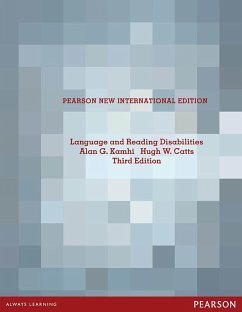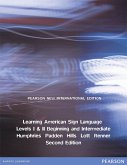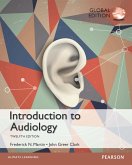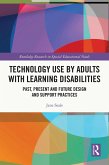Alan G. Kamhi, Hugh W. Catts
Language and Reading Disabilities (eBook, PDF)
Pearson New International Edition
37,95 €
37,95 €
inkl. MwSt.
Sofort per Download lieferbar

19 °P sammeln
37,95 €
Als Download kaufen

37,95 €
inkl. MwSt.
Sofort per Download lieferbar

19 °P sammeln
Jetzt verschenken
Alle Infos zum eBook verschenken
37,95 €
inkl. MwSt.
Sofort per Download lieferbar
Alle Infos zum eBook verschenken

19 °P sammeln
Alan G. Kamhi, Hugh W. Catts
Language and Reading Disabilities (eBook, PDF)
Pearson New International Edition
- Format: PDF
- Merkliste
- Auf die Merkliste
- Bewerten Bewerten
- Teilen
- Produkt teilen
- Produkterinnerung
- Produkterinnerung

Bitte loggen Sie sich zunächst in Ihr Kundenkonto ein oder registrieren Sie sich bei
bücher.de, um das eBook-Abo tolino select nutzen zu können.
Hier können Sie sich einloggen
Hier können Sie sich einloggen
Sie sind bereits eingeloggt. Klicken Sie auf 2. tolino select Abo, um fortzufahren.

Bitte loggen Sie sich zunächst in Ihr Kundenkonto ein oder registrieren Sie sich bei bücher.de, um das eBook-Abo tolino select nutzen zu können.
Language and Reading Disabilities
- Geräte: PC
- ohne Kopierschutz
- eBook Hilfe
Andere Kunden interessierten sich auch für
![Learning American Sign Language: Beginning & Intermediate (Levels 1-2) (eBook, PDF) Learning American Sign Language: Beginning & Intermediate (Levels 1-2) (eBook, PDF)]() Tom L. HumphriesLearning American Sign Language: Beginning & Intermediate (Levels 1-2) (eBook, PDF)37,95 €
Tom L. HumphriesLearning American Sign Language: Beginning & Intermediate (Levels 1-2) (eBook, PDF)37,95 €![Interactions (eBook, PDF) Interactions (eBook, PDF)]() Marilyn FriendInteractions (eBook, PDF)37,95 €
Marilyn FriendInteractions (eBook, PDF)37,95 €![Helping Young Children Learn Language and Literacy: Birth through Kindergarten (eBook, PDF) Helping Young Children Learn Language and Literacy: Birth through Kindergarten (eBook, PDF)]() Carol VukelichHelping Young Children Learn Language and Literacy: Birth through Kindergarten (eBook, PDF)37,95 €
Carol VukelichHelping Young Children Learn Language and Literacy: Birth through Kindergarten (eBook, PDF)37,95 €![Introduction to Audiology, Global Edition (eBook, PDF) Introduction to Audiology, Global Edition (eBook, PDF)]() Frederick N. MartinIntroduction to Audiology, Global Edition (eBook, PDF)37,95 €
Frederick N. MartinIntroduction to Audiology, Global Edition (eBook, PDF)37,95 €![Ethics and the Good Doctor (eBook, PDF) Ethics and the Good Doctor (eBook, PDF)]() Sabena JameelEthics and the Good Doctor (eBook, PDF)18,95 €
Sabena JameelEthics and the Good Doctor (eBook, PDF)18,95 €![Best Practices in Educational Therapy (eBook, PDF) Best Practices in Educational Therapy (eBook, PDF)]() Ann Parkinson KaganoffBest Practices in Educational Therapy (eBook, PDF)37,95 €
Ann Parkinson KaganoffBest Practices in Educational Therapy (eBook, PDF)37,95 €![Technology Use by Adults with Learning Disabilities (eBook, PDF) Technology Use by Adults with Learning Disabilities (eBook, PDF)]() Jane SealeTechnology Use by Adults with Learning Disabilities (eBook, PDF)40,95 €
Jane SealeTechnology Use by Adults with Learning Disabilities (eBook, PDF)40,95 €-
-
-
Language and Reading Disabilities
Dieser Download kann aus rechtlichen Gründen nur mit Rechnungsadresse in A, B, BG, CY, CZ, D, DK, EW, E, FIN, F, GR, HR, H, IRL, I, LT, L, LR, M, NL, PL, P, R, S, SLO, SK ausgeliefert werden.
Produktdetails
- Produktdetails
- Verlag: Pearson HigherEducation
- Seitenzahl: 328
- Altersempfehlung: ab 18 Jahre
- Erscheinungstermin: 27. August 2013
- Englisch
- ISBN-13: 9781292035192
- Artikelnr.: 41940040
- Verlag: Pearson HigherEducation
- Seitenzahl: 328
- Altersempfehlung: ab 18 Jahre
- Erscheinungstermin: 27. August 2013
- Englisch
- ISBN-13: 9781292035192
- Artikelnr.: 41940040
- Herstellerkennzeichnung Die Herstellerinformationen sind derzeit nicht verfügbar.
Preface
Acknowledgments
Contributors and Affiliations
CHAPTER 1: Language and Reading: Convergences and Divergences
Alan G. Kamhi and Hugh W. Catts
Defining Language
Phonology
Semantics
Morphology
Syntax
Pragmatics
Defining Reading
Models of Spoken and Written Language Comprehension
Comprehending Spoken and Written Language
Perceptual Analyses
Word Recognition
Discourse-Level Processes
Differences between Spoken and Written Language
Physical Differences
Situational Differences
Functional Differences
Form Differences
Vocabulary Differences
Grammatical Differences
Processing Differences
Basic Factors in Reading and Language Development
Summary
References
CHAPTER 2: Reading Development
Alan G. Kamhi and Hugh W. Catts
Emergent Literacy Period (Birth—Kindergarten)
Joint Book Reading
Learning about Print
Summary
The Development of Word Recognition Skills
Logographic Stage
Alphabetic Stage
Orthographic Stage and Automatic Word Recognition
Problems with Stage Theories of Word Recognition
The Self-Teaching Hypothesis
Evaluating the Self-Teaching Hypothesis
The Development of Reading Comprehension
Misconceptions about Comprehension Development
Summary
References
CHAPTER 3: Defining and Classifying Reading Disabilities
Hugh W. Catts, Alan G. Kamhi, and Suzanne A. Adlof
Historical Basis of Reading Disabilities
Early Reports
Orton
Johnson and Myklebust
The Modern Era
Terminology
Prevalence
Gender Differences
Defining Reading Disability
Exclusionary Factors
IDA Definition
Dyslexia as a Specific Learning Disability
Problems in Word Recognition and Spelling
Deficits in Phonological Processing
Unexpected Underachievement
Secondary Consequences
Classifying Dyslexia and Other Language-Based Reading Difficulties
Subtypes Based on the Simple View of Reading
Classification Studies
Other Subtyping Methods Based on Word Recognition Skills
Combining Subtypes in Research and Practice
Clinical Implications
References
CHAPTER 4: Causes of Reading Disabilities
Hugh W. Catts, alan G. Kamhi, and Suzanne A. Adlof
Extrinsic Causes of Reading Disabilities
Early Literacy Experience
Reading Instruction
Matthew Effects
Intrinsic Causes of Reading Disabilities
Genetic Basis
Neurological Basis
Visually-Based Deficits
Auditory Processing Deficits
Attention-Based Deficits
Language-Based Deficits
References
Acknowledgments
Contributors and Affiliations
CHAPTER 1: Language and Reading: Convergences and Divergences
Alan G. Kamhi and Hugh W. Catts
Defining Language
Phonology
Semantics
Morphology
Syntax
Pragmatics
Defining Reading
Models of Spoken and Written Language Comprehension
Comprehending Spoken and Written Language
Perceptual Analyses
Word Recognition
Discourse-Level Processes
Differences between Spoken and Written Language
Physical Differences
Situational Differences
Functional Differences
Form Differences
Vocabulary Differences
Grammatical Differences
Processing Differences
Basic Factors in Reading and Language Development
Summary
References
CHAPTER 2: Reading Development
Alan G. Kamhi and Hugh W. Catts
Emergent Literacy Period (Birth—Kindergarten)
Joint Book Reading
Learning about Print
Summary
The Development of Word Recognition Skills
Logographic Stage
Alphabetic Stage
Orthographic Stage and Automatic Word Recognition
Problems with Stage Theories of Word Recognition
The Self-Teaching Hypothesis
Evaluating the Self-Teaching Hypothesis
The Development of Reading Comprehension
Misconceptions about Comprehension Development
Summary
References
CHAPTER 3: Defining and Classifying Reading Disabilities
Hugh W. Catts, Alan G. Kamhi, and Suzanne A. Adlof
Historical Basis of Reading Disabilities
Early Reports
Orton
Johnson and Myklebust
The Modern Era
Terminology
Prevalence
Gender Differences
Defining Reading Disability
Exclusionary Factors
IDA Definition
Dyslexia as a Specific Learning Disability
Problems in Word Recognition and Spelling
Deficits in Phonological Processing
Unexpected Underachievement
Secondary Consequences
Classifying Dyslexia and Other Language-Based Reading Difficulties
Subtypes Based on the Simple View of Reading
Classification Studies
Other Subtyping Methods Based on Word Recognition Skills
Combining Subtypes in Research and Practice
Clinical Implications
References
CHAPTER 4: Causes of Reading Disabilities
Hugh W. Catts, alan G. Kamhi, and Suzanne A. Adlof
Extrinsic Causes of Reading Disabilities
Early Literacy Experience
Reading Instruction
Matthew Effects
Intrinsic Causes of Reading Disabilities
Genetic Basis
Neurological Basis
Visually-Based Deficits
Auditory Processing Deficits
Attention-Based Deficits
Language-Based Deficits
References
Preface
Acknowledgments
Contributors and Affiliations
CHAPTER 1: Language and Reading: Convergences and Divergences
Alan G. Kamhi and Hugh W. Catts
Defining Language
Phonology
Semantics
Morphology
Syntax
Pragmatics
Defining Reading
Models of Spoken and Written Language Comprehension
Comprehending Spoken and Written Language
Perceptual Analyses
Word Recognition
Discourse-Level Processes
Differences between Spoken and Written Language
Physical Differences
Situational Differences
Functional Differences
Form Differences
Vocabulary Differences
Grammatical Differences
Processing Differences
Basic Factors in Reading and Language Development
Summary
References
CHAPTER 2: Reading Development
Alan G. Kamhi and Hugh W. Catts
Emergent Literacy Period (Birth—Kindergarten)
Joint Book Reading
Learning about Print
Summary
The Development of Word Recognition Skills
Logographic Stage
Alphabetic Stage
Orthographic Stage and Automatic Word Recognition
Problems with Stage Theories of Word Recognition
The Self-Teaching Hypothesis
Evaluating the Self-Teaching Hypothesis
The Development of Reading Comprehension
Misconceptions about Comprehension Development
Summary
References
CHAPTER 3: Defining and Classifying Reading Disabilities
Hugh W. Catts, Alan G. Kamhi, and Suzanne A. Adlof
Historical Basis of Reading Disabilities
Early Reports
Orton
Johnson and Myklebust
The Modern Era
Terminology
Prevalence
Gender Differences
Defining Reading Disability
Exclusionary Factors
IDA Definition
Dyslexia as a Specific Learning Disability
Problems in Word Recognition and Spelling
Deficits in Phonological Processing
Unexpected Underachievement
Secondary Consequences
Classifying Dyslexia and Other Language-Based Reading Difficulties
Subtypes Based on the Simple View of Reading
Classification Studies
Other Subtyping Methods Based on Word Recognition Skills
Combining Subtypes in Research and Practice
Clinical Implications
References
CHAPTER 4: Causes of Reading Disabilities
Hugh W. Catts, alan G. Kamhi, and Suzanne A. Adlof
Extrinsic Causes of Reading Disabilities
Early Literacy Experience
Reading Instruction
Matthew Effects
Intrinsic Causes of Reading Disabilities
Genetic Basis
Neurological Basis
Visually-Based Deficits
Auditory Processing Deficits
Attention-Based Deficits
Language-Based Deficits
References
Acknowledgments
Contributors and Affiliations
CHAPTER 1: Language and Reading: Convergences and Divergences
Alan G. Kamhi and Hugh W. Catts
Defining Language
Phonology
Semantics
Morphology
Syntax
Pragmatics
Defining Reading
Models of Spoken and Written Language Comprehension
Comprehending Spoken and Written Language
Perceptual Analyses
Word Recognition
Discourse-Level Processes
Differences between Spoken and Written Language
Physical Differences
Situational Differences
Functional Differences
Form Differences
Vocabulary Differences
Grammatical Differences
Processing Differences
Basic Factors in Reading and Language Development
Summary
References
CHAPTER 2: Reading Development
Alan G. Kamhi and Hugh W. Catts
Emergent Literacy Period (Birth—Kindergarten)
Joint Book Reading
Learning about Print
Summary
The Development of Word Recognition Skills
Logographic Stage
Alphabetic Stage
Orthographic Stage and Automatic Word Recognition
Problems with Stage Theories of Word Recognition
The Self-Teaching Hypothesis
Evaluating the Self-Teaching Hypothesis
The Development of Reading Comprehension
Misconceptions about Comprehension Development
Summary
References
CHAPTER 3: Defining and Classifying Reading Disabilities
Hugh W. Catts, Alan G. Kamhi, and Suzanne A. Adlof
Historical Basis of Reading Disabilities
Early Reports
Orton
Johnson and Myklebust
The Modern Era
Terminology
Prevalence
Gender Differences
Defining Reading Disability
Exclusionary Factors
IDA Definition
Dyslexia as a Specific Learning Disability
Problems in Word Recognition and Spelling
Deficits in Phonological Processing
Unexpected Underachievement
Secondary Consequences
Classifying Dyslexia and Other Language-Based Reading Difficulties
Subtypes Based on the Simple View of Reading
Classification Studies
Other Subtyping Methods Based on Word Recognition Skills
Combining Subtypes in Research and Practice
Clinical Implications
References
CHAPTER 4: Causes of Reading Disabilities
Hugh W. Catts, alan G. Kamhi, and Suzanne A. Adlof
Extrinsic Causes of Reading Disabilities
Early Literacy Experience
Reading Instruction
Matthew Effects
Intrinsic Causes of Reading Disabilities
Genetic Basis
Neurological Basis
Visually-Based Deficits
Auditory Processing Deficits
Attention-Based Deficits
Language-Based Deficits
References







